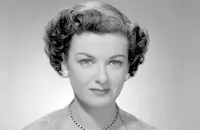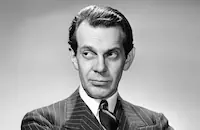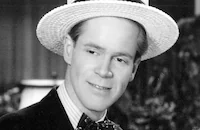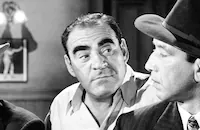The Woman in the Window

Brief Synopsis
Cast & Crew
Fritz Lang
Edward G. Robinson
Joan Bennett
Raymond Massey
Edmond Breon
Dan Duryea
Film Details
Technical Specs

Synopsis
After seeing his wife and children off on a summer vacation, Richard Wanley, a middle-aged psychology professor, heads to see his friends, District Attorney Frank Lalor and Dr. Barkstane, at their men's club. On his way to the club, the professor passes a portrait of a woman displayed in a gallery window and, mesmerized, pauses to admire the model's beauty. While seated with his friends at the club, the professor confides that his life is stodgy and devoid of adventure, prompting Lalor to tease him about his wife's absence and to warn him of the dangers of committing the slightest indiscretion. Several brandies later, the professor settles into his easy chair and asks the waiter to rouse him at 10:30. Later, after leaving the club, the professor is again drawn to the portrait and is startled to find the model standing beside it. Flattered by the professor's admiration, the woman, Alice Reed, invites him to her apartment to view more sketches of the artist's work. Hours later, the professor is still basking in Alice's beauty when suddenly, an irate man bursts into the room, accuses her of infidelity and attacks the professor. As the man encircles the professor's neck in a strangle hold, Alice slips a pair of scissors into the professor's hand and he stabs his assailant. Admitting that she was the man's mistress, Alice claims to know little about him other than his name, Frank Howard. The professor is about to notify the police but changes his mind and proposes that they dispose of the body instead. As the professor goes to pick up his car, Alice asks him to leave his vest behind to assure that he will return. Later, Alice searches the vest and finds a pencil with the initials "RW" engraved into it. Upon returning, the professor empties their victim's pockets and finds a watch engraved with the initials "CM." After instructing Alice to meticulously erase all traces of the death, the professor rolls the body in a blanket, stuffs it in the back seat of his car and drives off into the rainy night. Motoring into the country side, the professor crosses a toll bridge at the mouth of some woods. The professor stops, drags the corpse into a stand of trees, and after snagging his hand on a barbed wire fence, dumps the body and then drives away. The next day at the club, Lalor informs his friends that he is investigating the disappearance of wealthy financier Claude Mazard. At the mention of Mazard's name, the professor blurts out that Lalor should not automatically assume that the missing man was murdered. After Mazard's body is discovered in the woods by a Boy Scout, Lalor describes to the professor the clues found at the crime scene. When Lalor reveals that shreds of fiber from a jacket and drops of blood were discovered on a barbed wire fence, the professor exhibits his injured hand, which he claims to have scratched while opening a can. Just as Lalor mentions that Mazard has been linked to a woman, the district attorney is called away. Noticing that the professor is acting strangely, Dr. Barkstane prescribes a sleeping potion, and warns him that an overdose will prove lethal. Lalor then returns and theorizes that Mazard went to his mistress' house and there was killed by her male companion. He continues that Mazard's associates, distrustful of his volatile personality, hired a bodyguard to follow him, and the man, a wanted criminal, may also be involved in the murder. Lalor invites the professor to accompany him to the scene of the crime, and the next day, as Lalor waits to question the toll gate guard, Inspector Jackson of the homicide department arrives, comments on the professor's injured hand and then declares that the mysterious woman has been located. While walking to the spot where the body was found, the inspector describes the murderer's car based on the tire tracks found at the crime scene. As the professor becomes visibly agitated, the inspector teases him about confessing. When Jackson goes to meet the woman, the professor feigns illness and seeks refuge in the car, and from the back window, he determines that the woman is not Alice. Upon returning home, the professor receives a phone call from Alice, who is eager to tell him that she has seen his picture in the paper. At first believing that the photograph is connected to the murder, the professor is relieved when Alice congratulates him on the news of his promotion. After Alice finishes her conversation, Heidt, the man hired to tail Mazard, appears at the door and threatens to expose her unless she pays him $5,000. Ransacking her apartment, Heidt finds the scissors and the professor's pencil. As he spots the discarded newspaper featuring the professor's photograph, Alice snatches it up and pleads for time to raise the money. Giving her until the following evening, Heidt leaves and Alice then phones the professor and informs him of their predicament. Knowing that Heidt will continue to blackmail them, the professor gives Alice the cash and the sleeping powder, instructing her to slip the drug into Heidt's drink. That night, Heidt becomes suspicious when Alice tells him that she can only raise $2,900. When she offers him a drink, Heidt puts down the glass and declares that the price of his silence is that she accompany him to South America. After Alice nervously leaves the room to refresh his drink, Heidt demands that she swallow it. When Alice refuses, he becomes enraged and begins to search for the balance of the money. Behind some books, he finds the rest of the cash and Mazard's watch. Demanding another $5,000, Heidt pockets the watch and storms out of the apartment. Informed by Alice of their new dilemma, the professor, defeated, downs the sleeping powder. As Alice sobs uncontrollably on her bed, she is roused by the sound of gunshots. Running into the street, she learns that Heidt has just been shot by a police officer after he refused an order to halt. Alice calls the professor to tell him the good news, but the phone goes unanswered. The ringing eventually awakens the professor, who then falls into a death-like slumber. At the club, the professor is finally awakened by the waiter, who informs him that it is now 10:30. After realizing that the murder was just a dream, the professor recognizes the hat check man at the club as Mazard and the doorman as Heidt. As he passes the woman's portrait in the window, a street walker asks him for a light, sending him scurrying into the night.

Director

Fritz Lang
Cast

Edward G. Robinson

Joan Bennett

Raymond Massey
Edmond Breon

Dan Duryea
Thomas E. Jackson

Dorothy Peterson
Arthur Loft
Frank Dawson
Carol Cameron

Bobby Blake
Frank Melton
Don Brodie
Alec Craig
Frank Mills

Ralph Dunn
Lane Watson
James Beasley
Joe Devlin
Fred Graham
Tom Hanlon
Calvin Emery
Spanky Mcfarland
Harry Hayden
Jack Gardner
Arthur Space
Harold Mcnulty
Joel Mcginnis
Donald Kerr
Frank Mcclure
Anne O'neal
Fred Chapman
Anne Loos
Frances Morris
Eddie Chandler
Thomas P. Dillon

Iris Adrian
Ruth Valmy
Hal Craig
Fred Rapport
Alex Pollard
James Harrison
Jack Gargan
Lawrence Lathrop
William Lyer
Brandon Beach
Austin Badell
Al Benault
Paul Bradley
James Carlisle
William Holmes
Fred Fuceton
Sheldon Jett
J. W. Johnston
Charles Meskin
Harold Minjir
Ralph Norwood
Wedgwood Nowell
Louis Payne
Dave Pepper
Roy Seager
Scott Seaton
Wyndham Standing
Larry Steers
Crew
Duncan Cramer
B. F. Dalgleish
Harry Davis
Gene Fowler
Richard Harlan
Ed Henderson
Julia Heron
Marjorie Johnson
Nunnally Johnson
Nunnally Johnson
Muriel King
Milton Krasner
Arthur Lange
Paul Lerpae
Frank Mcwhorter
Earl B. Mounce
Milton W. Smith
Vernon Walker
Paul Weatherwax

Photo Collections
Videos
Movie Clip





Trailer
Hosted Intro
Film Details
Technical Specs

Award Nominations
Best Score
Articles
The Woman in the Window
SYNOPSIS: Edward G. Robinson is Richard Wanley, a middle-aged college professor who goes out for a few drinks when his wife and child are away on vacation. Afterwards, Wanley is admiring a painting in a store window when he notices that the beautiful model who posed for the portrait (Joan Bennett) is standing next to him. Wanley accepts an apparently innocent invitation to the woman's apartment, but unexpectedly winds up killing her abusive boyfriend. Horrified by his actions, Wanley then makes the mistake of disposing of the body, and is drawn into an increasingly nightmarish world of lies, deceit, and, possibly, another murder.
Robinson, who would work again with Lang on Scarlet Street the next year, was more concerned with politics on the set than the actual filming of The Woman in the Window if we are to believe this entry in his autobiography, All My Yesterdays: "For R.K.O. I made a picture called Woman in the Window with Joan Bennett and Raymond Massey, directed by Fritz Lang, one of the greats in his declining period. Among the cast - guess their names - there was violent and accusatory anti-Communist talk. At first I defended my Russian War Relief friends, the believers in Uncle Joe, the defenders of Stalingrad, the strength and will of the Russian people. Then, having failed to convince anybody of anything, except that I was a Communist manque, I retreated to my dressing room and kept my mouth shut. I do not like keeping my mouth shut."
Fritz Lang, however, was much more talkative about the pre- and post-production on The Woman in the Window in his interview with Charles Higham and Joel Greenberg for The Celluloid Muse: Hollywood Directors Speak: "The script for my next film, The Woman in the Window, was written by Nunnally Johnson and based on a story by J.H. Wallis called Once off Guard. They changed the title because they thought the word "guard" sounded too much like "God"....I liked the script for The Woman in the Window very much. There was only one thing wrong with it: all the male parts in it were written for old men, not only Edward G. Robinson's and the man who kept Joan Bennett, but also the part ultimately played by Dan Duryea. I'd liked Duryea's handling of the scene with the scissors in The Ministry of Fear so much that I was able to persuade the studio to let me bring him in; that was the only way I could introduce someone relatively youthful into the male cast. Various things appealed to me in the story, but I took the liberty of changing the ending with such a corny old trick that it seemed almost new...Thus I was able to end the film with a laugh."
Lang, like so many other talented filmmakers who migrated to America from Europe in the 1930s, often chafed under the dictates of the Hollywood system. Bennett had seen the frustrations Lang experienced while working with the domineering producer, Darryl F. Zanuck, and thought it was an outright shame. "(Zanuck) treated him like just anything," she later said, "and he was much more than that." So Bennett, her semi-independent producer husband, Walter Wanger, and Lang joined forces to create the Diana company, which gave Lang the artistic freedom he so richly deserved, and eventually lead to the production of The Woman in the Window.
Wanger, it should be noted, was just as happy as Lang was with this new venture. He had grown tired of being a unit producer at Universal, and badly wanted to get back to creating the sort of first rate pictures he made earlier in his career. With a director like Lang behind the camera, and with his talented wife starring, he was finally able to do so...at least until Diana folded several years later.
Lang, as you might expect, was passionate about filmmaking, so it's not surprising that he would make a bold move to become more independent. "Motion pictures are and have been the content of my life, everything," he once said while discussing The Woman in the Window. "You conceive a picture, you write it yourself or help to write it; that is the initial creative process. Then comes the actual direction, in which my crew and I work for months, very seriously, doing the best we can; that is the second stage of creation. Finally comes the cutting process, in which I always have the main say; that's the third time you create something."
From there, however, Lang deftly segued to his utter contempt for critics, many of whom were unhappy with The Woman in the Window's surprise ending. "At last you give the finished picture to the audience," he continued, "and along comes a reviewer who has to meet a morning edition dead-line. In addition, perhaps his wife is betraying him or maybe he has hemorrhoids or something. In any case, he cannot write an honest review, and, good or bad, favorable or unfavorable, I cannot accept it. That's why I don't give a damn about reviews."
Lang, when all was said and done, only gave a damn about the images and stories in his own mind. Neither critics nor controlling producers could sway him from his vision, and movie history is all the richer for it. Watch The Woman in the Window for an example of post-war filmmaking at its finest.
Director: Fritz Lang
Producer: Nunnally Johnson
Screenplay: Nunnally Johnson (based on the novel Once Off Guard by J.H. Wallis)
Editor: Marjorie Johnson, Gene Fowler, Jr.
Music: Arthur Lange
Art Design: Duncan Cramer
Set Design: Julia Heron
Special Effects: Vernon L. Walker
Costumes: Muriel King
Cast: Edward G. Robinson (Prof. Richard Wanley), Joan Bennett (Alice Reed), Raymond Massey (Frank Lalor), Edmund Breon (Dr. Michael Barkstone), Dan Duryea (Heidt/Doorman), Thomas Jackson (Inspector Jackson), Arthur Loft (Claude Mazard/Frank Howard), Dorothy Peterson (Mrs. Wanley), Frank Dawson (Collins), Carol Cameron (Elsie Wanley), Robert Blake (Dickie Wanley).
B&W-99m.
by Paul Tatara

The Woman in the Window
The Woman in the Window - Joan Bennett & Edward G. Robinson in Fritz Lang's Film Noir, THE WOMAN IN THE WINDOW.
The Woman in the Window is, simply, a classic film noir. Edward G. Robinson plays a New York college philosophy professor who is rather bored with his steady, monotonous life. He has a wife and kids, but his only outlet for fun seems to be his nightly visits to his club, where he talks with friends Raymond Massey and Edmond Breon, playing, respectively, a district attorney and a doctor. One night, all three discuss their lust for the subject of a portrait hanging in a window next to their club, and it's obvious that Robinson has fantasies and dreams that will seemingly never come out and see the light of day. That changes when he leaves the club and has another long look at the painting while standing on the sidewalk, only to have the subject herself - Joan Bennett - suddenly appear beside him.
He turns to look at her and is of course smitten. A friendly drink leads to a friendly visit back to her place, where another man soon walks in and attacks Robinson in a fit of jealousy. Defending himself, Robinson kills him, and now the story really begins as Robinson and Bennett cover up the incident. Their struggle to determine how to proceed, followed by Robinson's time-consuming disposal of the body, is presented completely and methodically. Lang is smart not to cut this section down for it allows us to fully align with Robinson and what he is going through inside, and to share the paranoia of the situation. That in a nutshell is what Lang was especially good at throughout his career - making his audience enter the psyches of tortured, furious or obsessive characters - and he does an exemplary job here. As Robinson's friend Massey leads an investigation into the murder, Robinson does fine work at inadvertently drawing more and more suspicion onto himself thanks to his naivete, lack of experience in concealing crimes, and general bad luck.
But in film noir of course, it's not really bad luck but rather fate that gets you in the end. Robinson here is a decent and kind man who simply makes a bad (though innocent) decision, and from then on must pay a heavy price as incident piles upon incident and he is pulled ever deeper into the mire. The Woman in the Window positively oozes dread and paranoia, and it conveys a feeling of being in a nightmare over which one has no control. Movies don't get much more noir than that.
Dan Duryea eventually enters the picture as an oily blackmailer, and he has some terrific scenes with Bennett, but it's primarily through Robinson that we experience this story and the aforementioned dread. The movie is on the way to seemingly the bleakest of endings before an unexpected and famous twist. Many feel the ending is a cop-out, but somehow it works, and it certainly doesn't invalidate the feelings the movie has evoked up to that point.
The Woman in the Window is a masterful achievement by all concerned and is worth the rather high DVD price, which is especially so considering there are no extras. Picture and sound are very good.
Lang, Robinson, Bennett and Duryea would reunite a year later for the even-better Scarlet Street (1945).
For more information about The Woman in the Window, visit MGM Home Entertainment. To order The Woman in the Window, go to TCM Shopping.
by Jeremy Arnold
The Woman in the Window - Joan Bennett & Edward G. Robinson in Fritz Lang's Film Noir, THE WOMAN IN THE WINDOW.
Quotes
The streets were dark with something more than night.- Richard Wanley
Trivia
Notes
The working title of this picture was Once Off Guard. Hollywood Reporter news items yield the following information about its production: In November 1943, English actor Harry Lester was tested for a featured role and Fritz Lang hoped to cast New York police officer Johnny Broderick as himself in the film. In March 1944, Merle Oberon was announced in the part of "Alice Reed." Also in March 1944, Chicago police officer Alicia Murphy was tested for the part of the jail matron in the film, but her appearance in the released film has not been confirmed. Although a Hollywood Reporter production chart places Gloria de River in the cast, her appearance in the released film has not been confirmed. In December 1943, background footage was shot in New York City. In May and June 1944, the film was shot on soundstages at the Goldwyn, Paramount, RKO, PRC and Selznick studios, according to other Hollywood Reporter news items. The portrait of Joan Bennett in the film was painted by Paul Clemens, according to another Hollywood Reporter news item. Raymond Massey was borrowed from Warner Bros. to appear in this picture. In a modern interview, Lang stated that producer Nunnally Johnson opposed the film's dream ending. The film received an Academy Award nomination in the Music (Music Score of a Dramatic or Comedy Picture) category. On June 25, 1945, Lux Radio Theatre broadcast a radio version of the story, which also starred Bennett and Edward G. Robinson. In 1945, Lang brought actors Bennett, Robinson and Dan Duryea together again with director of photography Milton Krasner to film Scarlet Street.

Miscellaneous Notes
Released in United States 1944
Released in United States March 1977
Released in United States March 1977 (Shown at FILMEX: Los Angeles International Film Exposition (A Tribute to Fritz Lang) March 9-27, 1977.)
Released in United States 1944















